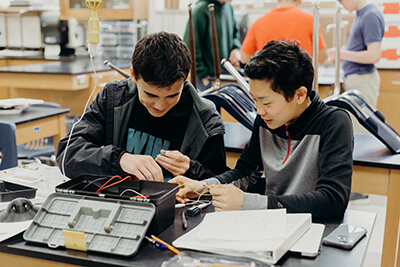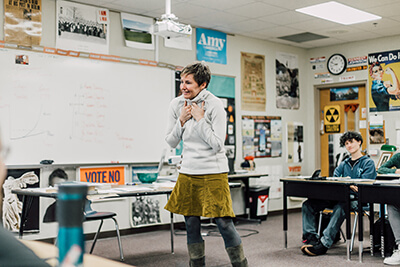Academic Rigor
Academic rigor reaches a crescendo in the Upper School at MPA. Teachers ask more of their students, students expect more from their peers, and everyone knows that college applications and life decisions loom on the horizon.
Across all divisions, but perhaps no more than in the Upper School, MPA teachers ask for the why and the how behind everything. “Why do protons behave in that way?” “How can we connect our primary sources to current events?” “How did you arrive at that conclusion in your proof?” “Why is the subjunctive tense used here?”
As a result, classes are engaging, hands on, and challenging, especially for voracious learners. Rigor means that students are not told how to solve problems, but rather given the chance to explore and discover an applicable solution.
This is apparent for anyone who has been on campus and seen the exceptionally high levels of student engagement. Because at MPA, rigor equates to participation and involvement. It means that students are not sitting in the back, bored, disengaged and distracted, but instead are challenged, attentive, actively participating, and eager to be diving deep into complex concepts.
Rigor appears in many different ways in the Upper School. Some, like accelerated world language options and high level math offerings (AP Calculus BC, for example) fall in the more recognizable, traditional indicators of rigor. Others, like Design Thinking exercises in the Makerspace and high level playwriting critiques in Winter Show, are unique to MPA. But one thing is clear, our highly rigorous education does not mean attempting to challenge top students by piling on busywork, nor does it mean taking away support and individual attention from a teacher. Rigor at MPA is about diving deeper.
Let’s take a closer look at academic rigor in four Upper School content areas.
The Sciences
 The Upper School science pathway starts with physics in ninth grade, a rigorous course than goes more in depth than the more commonly offered alternatives like physical science or earth science. This ensures that students looking for academic rigor in the sciences will find it right away, and everyone will have a strong foundation in science at its most anatomical level.
The Upper School science pathway starts with physics in ninth grade, a rigorous course than goes more in depth than the more commonly offered alternatives like physical science or earth science. This ensures that students looking for academic rigor in the sciences will find it right away, and everyone will have a strong foundation in science at its most anatomical level.
From there, most students looking for additional academic rigor take advantage of the opportunity to take honors biology in 10th grade and honors chemistry in 11th grade. This rigorous sequence of courses provides the necessary preparation for highly motivated students looking to challenge themselves with AP Biology in 12th grade.
As seniors, MPA students choose from following classes: Adv. Physics: Mechanics, Ad. Physics: Waves, Optics & Electromagnetism, Adv. Topics in Chemistry, Anatomy and Physiology, Astronomy, Biotechnology, Earth, Atmosphere, & Planetary Science, Environmental Chemistry, Environmental Science, and/or Neuroscience. Each class provides a level of rigor and deep content knowledge more typical of collegiate science courses.
Across Upper School science classes, rigor is incorporated through an average of 160 minutes of laboratory time per week. With this much time in the science lab, MPA graduates planning to pursue the sciences in college and graduate school are prepared exceptionally well for the rigorous lab components they’ll be facing in college science.
Humanities
 Academic rigor in the humanities appears in myriad ways. Students in Upper School English and social studies read primary source documents at an accelerated pace, respond to assigned reading with complex literary and historical analysis, scrutinize and cite peer reviewed journals and papers, and construct original arguments and ideas.
Academic rigor in the humanities appears in myriad ways. Students in Upper School English and social studies read primary source documents at an accelerated pace, respond to assigned reading with complex literary and historical analysis, scrutinize and cite peer reviewed journals and papers, and construct original arguments and ideas.
Students looking for additional rigor in the humanities often choose to begin with Honors World History 9, a prerequisite for AP World History in grade 10. In this two-year sequence, honors students consume extensive primary and secondary sources, considering multiple viewpoints and historical biases in a course filled with extensive opportunities for discussion, debate, and analytical writing. For example, World History 9 culminates with a Middle East peace conference, where students are asked to overcome challenges and conflicts, gather data from multiple resources, and problem solve collaboratively to produce a diplomatic resolution.
MPA’s interdisciplinary American Studies course combines both English and social studies for all 11th graders. This course asks students to analyze the historical events that shaped United States’ history through the complex lens of period literature while prompting them to make connections to the larger world and current events. Taking a chronological approach beginning with indigenous cultures and continuing to the present day, the course ensures students gain a deep understanding of the nuanced history of the United States through literature-based units. This approach to teaching U.S. history and American literature together gives students a deeper, more rigorous, and more engaging experience than they could expect from a single-discipline approach.
In a student’s final year of Upper School, seniors choose four courses from a wide selection that includes AP English Literature, Creative Writing, Contemporary Women Writers, Fiction and Literary Adaptation, Sci Fi and the Politics of Imagination, Living the Blues: Music and the Harlem Renaissance. In Constitutional Law, students research a case currently before the U.S. Supreme Court, then present oral argumentation on that case before a panel of judges and lawyers with Minnesota Court of Appeals in person at the Minnesota Judicial Center on the grounds of the Minnesota State Capitol.
Mathematics
 With five distinct tracts in Upper School mathematics, students seeking the highest level of rigor can be among their peers in a challenging, analytical, and highly intellectual environment. Extremely small class sizes and frequent 1:1 attention from master teachers help students excel.
With five distinct tracts in Upper School mathematics, students seeking the highest level of rigor can be among their peers in a challenging, analytical, and highly intellectual environment. Extremely small class sizes and frequent 1:1 attention from master teachers help students excel.
Those looking for the most challenging math sequence begin in ninth grade with Honors Algebra 2/3, a fast paced class that combines topics from two classes, Advanced Algebra 2/Trigonometry and Advanced Algebra 3/Advanced Trigonometry, into a one year course designed to prepare students for Honors Pre-Calculus. Sophomores within this most rigorous math pathway take Honors Pre-Calculus. This course provides rigor through an emphasis on experimentation, mathematical problem solving, and logic.
In 11th and 12th grades, students continuing in the top math pathway take AP Calculus AB and AP Calculus BC, the same content typically covered in collegiate Calculus I and II classes. Students are challenged to use advanced Calculus methods to describe movement, area, volume and density, model physical situations using functions, derivatives and integrals, and solve problems based in science and engineering. To succeed through the rigor of AP Calculus courses, student must display superior algebra skills and well-developed geometric thinking, as well as excellent recall of previously learned math concepts. They must be able to understand the mathematical processes that go far beyond a rote memorization of the material.
In addition to AP Calculus, students in 12th grade are also invited to add to their mathematics course load with a challenging, college level AP Statistics class in which they interpret data, learn graphing methods, calculate measures of central tendency, analyze statistical hypotheses, evaluate trends, construct scatter plots, and determine regression lines and correlation coefficients.
 World Language
World Language
For many students, simply starting a world language in the Upper School provides a new and challenging academic course. For those who come to MPA in Upper School with previous experience in Spanish or French, MPA’s multitiered world language curriculum offers them the opportunity to find their appropriate level of academic rigor. From Spanish/French I through Spanish/French VI, (plus Spanish/French AP Language and Culture), there is a class that’s the right fit for everyone.
All MPA Upper School students are required to take world language classes, and those looking to challenge themselves in Spanish or French take level IV in ninth grade (already the rigor of an intermediate college course). They move on to level V in 10th grade, then level VI in 11th grade and finally AP Language and Culture in 12th grade. Across each of these classes, rigor is incorporated through both deciphering complex grammar and comprehending the cultural intricacies of the Spanish speaking or Francophone worlds. Mastering each of the four modalities, reading, speaking, writing and listening makes for students who are highly experienced and confident in their language abilities.
Students improve their speaking fluency through discussions and debates that take place 100% in Spanish/French, and their writing accuracy through multipage analytical essays, also completely in Spanish/French. Reading skills are reinforced with extensive interpretation of original texts: newspaper and magazine articles, poetry, short stories, and novels, while listening comprehension comes from consuming native language music, movies, news segments, and peer to peer conversations.
Though each of the four language modalities, as well as grammar and vocabulary are vitally important, world language classes truly come alive, and provide the most challenging, academically rigorous content through detailed dives into the cultural and historical environments of Spanish speaking and Francophone countries. For example, French V students study French literary masterpieces from the Middle Ages to the 21st Century, analyzing each novel in depth and in French. In Spanish VI, students explore the twentieth and twenty first century events in the Spanish speaking world, from Operation Condor in South America to Liberation Theology in Central America. And Spanish V provides an introduction to Spanish history from the Moorish invasion of the Iberian Peninsula in 711 and the days of La Alhambra to the colonization of the Americas. Across the world languages, academic rigor emerges from high level cultural studies.